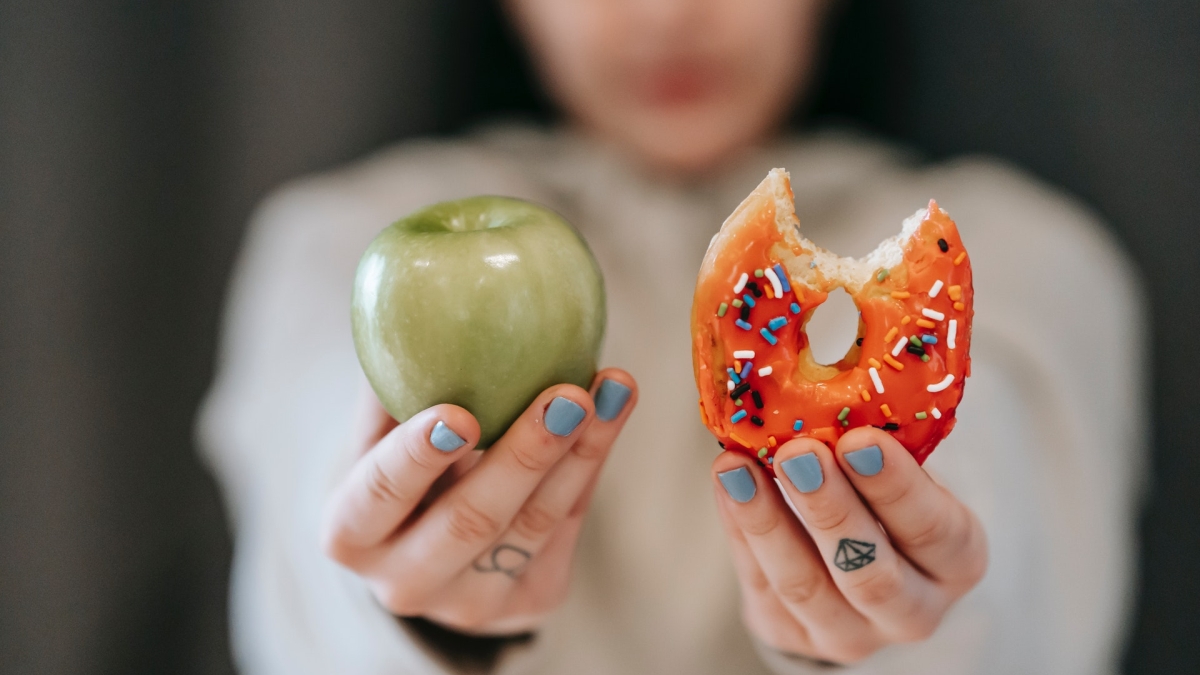Research shows marketers, policymakers should avoid 'one-size-fits-all' diet approach
ASU professor found dieters split between 'abstainers' and 'moderators'

For some people who indulged over winter break, January might be a time of dieting.
But which kind of diet? Banning all treats or allowing some “cheats?”
A new study by a marketing professor at Arizona State University finds that figuring out which type of dieter you are and then sticking to that model might be the best method. And marketers and government policy should take those differences into account and avoid a “one-size-fits-all” approach.
Naomi Mandel, professor of marketing in the W. P. Carey School of Business, created an eight-question “Diet Balancing Scale” and then ran several studies to prove its validity. Her paper, “Not all dieters are the same: Development of the Diet Balancing Scale,” recently was published in the Journal of Business Research. Her co-authors were Yi (Fionna) Xie, who was a doctoral student at ASU during the study and is now an assistant professor of marketing at Xiamen University in China, and Meryl Gardner, professor of marketing at the University of Delaware.
“I think the idea just came from our own experiences with dieting and having some successes and failures,” Mandel said.
“And among us, we had different approaches. Fionna told us that it’s very common in China to have diets with ‘cheat days’ built in,” she said.
“That’s a form of balancing moderation where maybe one day a week you can pig out or do what you want, and for a lot of people, it makes a diet easier knowing you can indulge.”
But not for everyone. Some people embrace the “abstainer” approach.
“I know that for me, once I start indulging, it’s very hard for me to stop,” Mandel said, recalling one Halloween when she pilfered her daughter’s candy.
“That’s when I realized that if I have a little bit, I can’t stop. I need to cut it out of my life.”
The authors were inspired by a concept from lifestyle author and blogger Gretchen Rubin.
“On her blog, she talks about ‘abstainers’ and ‘moderators,’” Mandel said.
“I’ve always been interested in this idea, and I had not seen much in the academic literature about it. I felt like there was probably a gap and there should be a paper about it.”
The authors decided to start with Rubin’s quiz and turn it into a formal scale that measures people’s self-beliefs about diet.
“We started with a big collection of questions and were able to scale the quiz down to eight questions that were the best predictors of which group you fall into,” she said.
The scale includes “yes” or “no” questions such as “Refusing ANY food temptations is an easier strategy for me to keep my diet on track” and “I feel more relaxed knowing that I have the chance to satisfy my cravings with an occasional food indulgence.”
The researchers then ran several studies to validate the soundness of the tool.
Mandel answered some questions from ASU News about the paper.
Question: Is either approach, abstainers or moderators, more successful?
Answer: We didn’t find any evidence for that. Abstainers and balancers have approximately the same BMI. They’ve had approximately the same level of success with dieting and with prior weight loss. One approach is not better than the other.
Q: One of the studies you ran involved M&Ms. What were you looking for there?
A: We wanted to see if there was a self-fulfilling prophecy going on. After indulging, would abstainers have more of a problem getting back on the wagon and going back to eating less? And would balancers have an easier time balancing out and eating less later?
It was a complicated experiment design because we can bring people into the lab and give them food and measure what they eat, but we can’t force them to indulge by giving them a brownie because it’s not the same as them choosing to indulge. They would rationalize, “I had to do it because the lab assistant made me.”
We asked them to recall a time in the past when they indulged, like having a slice of cake on their birthday or on Thanksgiving, or when they abstained. And they wrote down their thoughts about when that happened. We wanted to see after recalling an indulgence how much they would eat right afterward.
So we gave them M&Ms and said, “This is a different study. We’re seeing how well M&Ms go with different videos.” And we measured how many M&Ms they ate.
Q: And what did you find?
A: It was indicative of a self-fulfilling prophecy – the balancers who thought about prior indulgence ate fewer M&Ms. Abstainers who were thinking about indulgence ate slightly more M&Ms.
It was a small difference.
Q: And another study you ran looked at attitudes about advertisements?
A: We wanted to look at people’s responses to ads that use taglines emphasizing either abstaining or balancing. So we made some ad mockups of a hypothetical yogurt brand.
The example of the “balancing” ad said something like, “You can eat everything in moderation.” It was emphasizing that if you eat this yogurt, you’re indulging but it’s not that bad. The example of the abstaining ad said something like, “Because you don’t need the bad stuff.”
We wanted to see if these would appeal differently to abstainers and balancers, and they did.
The balancers showed the strongest differences. They like to see ads that emphasize balance and don’t like ads that emphasize abstaining. People who are balancers don’t like being told they can’t have something. They want the option to make their own choices. They want to eat pizza and cake, and they can do that by balancing with more exercise or salad.
Abstainers reacted similarly to both ads. We don’t know why, but we think most ads out there emphasize balance, and they’re probably used to that.
Q: So what’s the overall messaging?
A: I’m going to speculate here, because this goes a little beyond what we studied.
Some people have a genetic predisposition for gaining weight. Some people have an easier time maintaining and not gaining.
I think in the future, doctors and nutritionists will take a different approach – a more customized approach – instead of saying, “Count your calories.” Research is finding that people respond differently to differently diets. I think we’ll see more customized recommendations in the future. Hopefully, the government recommendations in My Plate won’t be so strict.
Some apps already offer customized recommendations but could use our measuring tool to inform people what sort of diets they should follow. And there are all kinds of food delivery services now that could incorporate our quiz to inform on the type of food people might want.
Top image courtesy of Pexels.com
More Health and medicine

First exchange student for Biodesign Institute Europe bridges labs 5,000 miles apart
This spring semester, Grace Colley traveled to Arizona State University and became the first student to participate in the Biodesign Institute Europe student exchange program. In doing so, she helped…

College of Health Solutions hosts visit from leading expert in genomic research
Some fortunate Arizona State University faculty, staff and students were able to gain valuable insights and perspective during a visit by one of the country’s leading figures in health and scientific…

Indigenous ASU research team recommends assistance for tribal members still reeling from COVID-19’s effects
When Matt Ignacio’s tribe, the Tohono O’odham Nation, donated $1 million to Arizona State University to support COVID-19 research, he applied for some of the money to understand and report any…